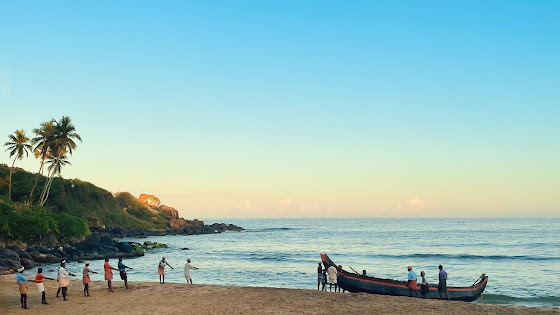Nature Speaks
Tuesday, October 3, 2023
Friday, September 29, 2023
Thursday, September 28, 2023
The Art of Living Together
All Nature is linked together by invisible bonds and every organic creature, however low, however feeble, however dependent, is necessary to the well-being of some other among the myriad forms of life. — George Perkins Marsh
Duckweed is the tiny floating plant often seen covering the surface of ponds. It is packed with nutrients such as protein as well as vitamins which serve as a dietary supplement for ducks especially during the breeding and migration seasons. The relationship between ducks and duckweed is a prime example of symbiosis in nature. Ducks help control the growth of duckweed by preventing it from overtaking a water body, while duckweed provides ducks with a nutritious food source. Apart from this, the weed offers a home for several microorganisms by providing natural shade and shelter for young fish and amphibians. This intricate connection is essential for maintaining a healthy aquatic ecosystem.
A tryst with nature #duck #photography
Saturday, September 9, 2023
Green Malachite Butterfly
Green Malachite butterflies are known for their vibrant green and black coloration. They have green wings with black stripes and a wingspan of about 8 to 10 centimetres. These butterflies are native to tropical as well as subtropical regions of the America. They are strong fliers and can manoeuvre through the dense foliage easily. Malachites undergo a complete metamorphic life cycle, consisting of four stages: egg, larva (caterpillar), pupa (chrysalis) and adult butterfly. These butterflies are not considered endangered.
Tuesday, September 5, 2023
Meadow Brown
Meadow Browns are common to Europe, Asia and North Africa during the summer months. Their habitats include meadows and grasslands. These butterflies have wings that are primarily brown with a distinctive eye spot on each forewing. The wingspan typically ranges from 4 to 6 centimeters. The caterpillars of Meadow Browns primarily feed on grasses which are plenty in the meadow habitats. The brown wings with eye spots help meadow browns to blend into the grassy environments, providing some protection from predators. The lifecycle comprises of four stages - egg, Larval Stage (Caterpillar), Pupal Stage (Chrysalis) and Adult Stage (Butterfly). Meadow Browns is a species of least concern in terms of conservation status and play a vital role in pollination.
A tryst with nature #meadowbrown #photography
This post is part of Blogchatter's Half Marathon
Saturday, September 2, 2023
Red Admiral Butterfly
Red Admirals are commonly observed in various habitats such as gardens, meadows and woodland edges of North America, Europe, Asia as well as North Africa. They have a distinctive appearance with dark black or brownish-black wings and red-orange bands across the forewings. They also have white spots on their wings. The wingspan of these fascinating butterflies range from 2.0 to 2.75 inches.
These butterflies exhibit migratory behaviour patterns with populations often moving north during the spring and summer and then returning south during the fall. The caterpillars of the Red Admiral feed on various plants such as nettles. Despite their vibrant colours, Red Admirals are known for their ability to blend into their surroundings when their wings are closed as the dark undersides of their wings provide an excellent camouflage.
Like all butterflies, Red Admirals undergo complete metamorphosis, which includes four stages: egg, larva, pupa and adult butterfly.
Red Admirals are generally considered to be of least concern and their numbers can vary from year to year due to factors such as weather and food availability.
A tryst with nature #redadmiral #photography
This post is part of Blogchatter's Half Marathon
Friday, September 1, 2023
Banded Demoiselle
Banded Demoiselle is a species of damselfly commonly found in Europe and parts of Asia along slow-flowing streams and rivers with muddy bottoms. They are 45mm long and have a metallic, iridescent blue-green body with large, dark blue-black wing patches. The females are generally less colourful, with greenish bodies as well as clear wings. Males are territorial and often perform aerial displays or combats to attract females.
Banded demoiselles have an aquatic larval stage, which is spent in the water. They undergo an incomplete metamorphosis, involving three life stages: egg, nymph and adult. After spending several months as aquatic nymphs, they emerge from the water and turn into adults. Both nymphs and adults are carnivorous and mainly feed on small aquatic invertebrates, and flying insects. Banded demoiselles are preyed upon by birds, larger insects and spiders. Their bright colours serve as a warning to predators that they may be toxic for consumption.
These damselflies are typically active during the summer months and currently their numbers are impacted by pollution, over-shading from tree growth as well as removal of aquatic vegetation.
A tryst with nature #bandeddemoiselle #photography
This post is part of Blogchatter's Half Marathon
Subscribe to:
Posts (Atom)
-
"When bluebells ring their bells the wintry gloom dispels." A sea of bluebells are a highlight of spring. They are native to wes...
-
"I love to hop from here to there . Make a quick stop to catch some air!” Around the world people hold varying opinions about rabbits...
-
“Flowers are a proud assertion that a ray of beauty out values all the utilities in the world.”– Ralph Waldo Emerson African daisies look a ...






















